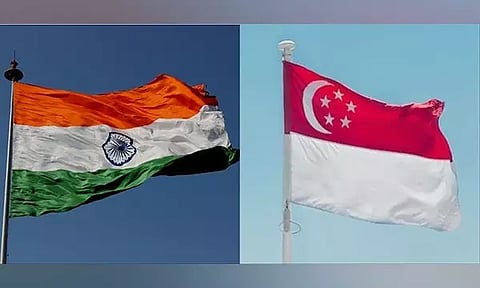

SINGAPORE: For the first time since the global financial crisis of 2008, global household wealth in 2022 (in US dollars) decreased on aggregate as well as on a per-adult basis, both in nominal and real terms.
Wealth per adult also recorded the second-largest reduction since 2000. This was revealed in a recent Credit Suisse-UBS report by the Swiss Bank’s Family Office and UHNW (ultra-high net worth) division.
The fourteenth edition of the Credit Suisse Global Wealth Report which this year is published jointly with UBS, covers estimates of the wealth holdings of 5.4 billion adults around the world and across the wealth spectrum.
Measured in current nominal US dollar terms, total net private wealth declined USD 11.3 trillion (-2.4 per cent) to USD 454.4 trillion at the end of 2022.
Wealth per adult also declined by USD 3,198 (-3.6 per cent) to reach USD 84,718 per adult. Much of this decline comes from the appreciation of the US dollar against many other currencies.
Financial assets, like stocks and currency deposits, contributed most to wealth declines in 2022 while non-financial assets (mostly real estate) stayed strong, despite rapidly rising interest rates.
However, the report cautioned that the relative contributions of financial and non-financial assets may reverse in 2023 if house prices decline in response to higher interest rates.
If exchange rates are held constant at 2021 rates, then total wealth increased by 3.4 per cent and wealth per adult by 2.2 per cent during 2022. This is still the slowest increase of wealth at constant exchange rates since 2008.
Keeping exchange rates constant but counting the effects of inflation results in a real wealth loss of 2.6 per cent in 2022.
The report also suggested that the decrease in 2022 global wealth may be due to extraordinary circumstances during the Covid-19 years.
During the first phase of the Covid-19 pandemic in 2020, because of financial support given to households by central governments in many advanced countries, household wealth remained robust despite economic setbacks experienced throughout the world.
This coupled with lower interest rates and limitations on consumption opportunities, culminated in higher household savings and led to widespread increases in share prices and house prices.
In 2021, these trends were reinforced as macroeconomic activity recovered in a low-interest environment. This produced exceptionally advantageous conditions for household wealth growth, resulting in the most rapid rise in household wealth recorded.
As we now know, this combination of favourable conditions did not last. As interest rates rose and stock markets fell, global wealth reversed, especially in the richer nations.
It was most keenly felt in North America and Europe which together shed USD 10.9 trillion. Asia Pacific recorded losses of USD 2.1 trillion, while Latin America is the outlier with a total wealth increase of USD 2.4 trillion, helped by an average 6 per cent currency appreciation against the US dollar.
The report observed that “the markets that lost substantial wealth in 2022 … were often those that made sizeable gains the year before.”
In 2022, the United States, Japan, China, Canada and Australia were the countries that saw the largest decline in wealth. India was one of few countries which experienced a wealth increase and along with Russia, Mexico and Brazil saw the largest wealth expansion.
In terms of wealth per adult, Switzerland continues to top the list followed by the USA, Hong Kong, Australia and Denmark despite sizeable reductions in mean wealth versus 2021.
Ranking markets by median wealth results in a different list, with Belgium in the lead followed by Australia, Hong Kong, New Zealand and Denmark.
Along with the decline in aggregate wealth, overall wealth inequality also fell in 2022, with the wealth share of the global top 1 per cent falling to 44.5 per cent.
This figure was 45.6 per cent in 2021, and 43.9 per cent in 2019. The number of USD millionaires worldwide fell by 3.5 million during 2022 to 59.4 million. This figure does not, however, take into account 4.4 million “inflation millionaires” who would no longer qualify if the millionaire threshold were adjusted for inflation in 2022.
Global median wealth, perhaps a more meaningful indicator of how the typical person is faring, did in fact increase by 3 per cent in 2022 in contrast to the 3.6 per cent fall in wealth per adult.
In one of the wealthiest countries in the world, Singapore, median wealth rose 6.2 per cent from 2021 to hit USD 99,488 in 2022. Average household wealth rose 7.2 per cent in 2022 to USD 1.906 trillion, while on a per-adult basis, wealth increased 6.3 per cent.
There were 332,000 millionaires in Singapore in 2022, up 10.3 per cent from 2021. India has seen a steady increase in wealth over the last 20 years. On average, wealth per adult has risen at an annual rate of 8.7 per cent since the year 2000 and was USD 16,500 at the end of 2022.
There was a rise in wealth of 2.8 per cent per adult compared with a year ago, whereas total household wealth was higher by 4.6 per cent. After rising 31 per cent in 2021, Indian share prices eked up a modest gain of 2.4 per cent in 2022 despite the falling value of other stock markets.
This together with a resilient property market helped Indians maintain their overall financial standing. In the longer term, the authors of the Credit Suisse-UBS wealth report project that global wealth will rise 38 per cent over the next five years to reach USD 629 trillion by 2027.
It expects middle-income countries to be the main driver of global trends.
The report estimates that wealth per adult will reach USD 110,270 in 2027 and the number of millionaires to reach 86 million while the number of ultra-high-net-worth individuals (UHNWIs), people with at least USD 50 million in assets, is likely to rise to 372,000 individuals.